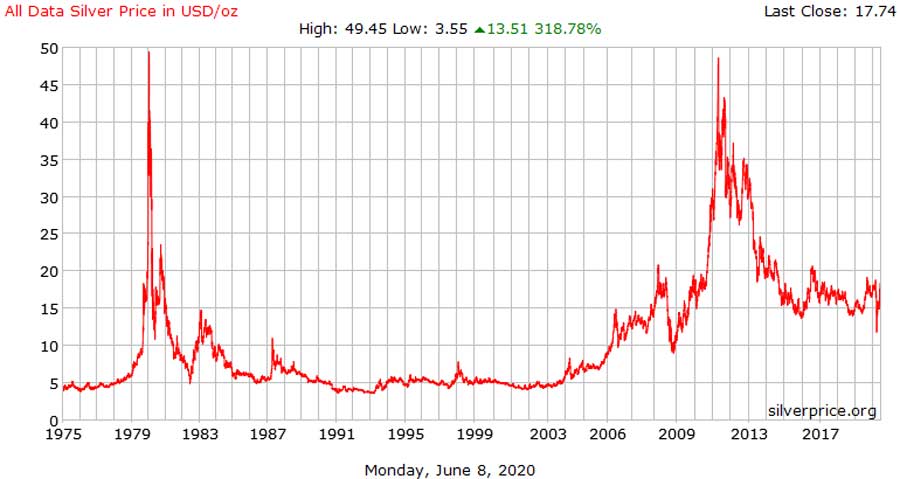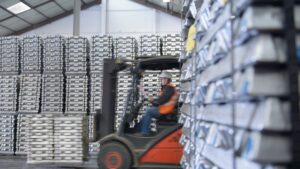Repeating history: Is the silver price about to break out?

Pic: Bloomberg Creative / Bloomberg Creative Photos via Getty Images
History tells us that silver — while not as universally loved by investors as gold — has the ability to outperform its precious metal rival.
Based on historical silver data, there has only ever been two occasions when the silver price has run hard — and both times followed recessions.
The first time the price went from sub-$US5 ($7.15) an ounce during the 1970s recession to almost $US50 ($71.54) an ounce in the early 80s. The second time, following the GFC, silver again ran hard, from below $US10 an ounce to over $US45 an ounce in 2011.

These short-term percentage gains at the time far exceeded gold’s gains during the same timeframes.
For example, following the 1970s recession gold advanced roughly 300 per cent to silver’s 900 per cent in US dollar terms.
The silver price typically follows the gold price, but it takes some time for it to wake up. So while gold has been running for a while now, it looks as if silver has just started to emerge from its slumber.
In the past month it has advanced nearly 15 per cent to just under $US18 ($26) an ounce.
“I really think gold is the bellwether. Silver is not the poor second cousin but still a long way behind gold as a favoured metal,” Guy Le Page, director and responsible executive at Perth-based financial services provider RM Corporate Finance, told Stockhead.
Meanwhile, Gavin Wendt, senior resources analyst and founding director of MineLife, sees gold’s head start as more of a “litmus test” for the silver price.
“Gold is sort of like a lead indicator,” he told Stockhead.
“Whatever is driving gold — market conditions, whether it’s a risk-on or a risk-off sort of market scenario — if there is a positive market situation for gold, gold is the commodity that moves first.
“Investors then start to look at the silver price and what you tend to see is that ‘gold-silver ratio’ opening up and everybody starts looking at the silver price and wondering when silver will start to move.
“But it is gold’s fundamental initial movement that ultimately is the catalyst for the silver price.”
The gold-silver ratio is the number of ounces of silver it takes to buy one ounce of gold.
Any widening in the ratio above the long-term average of 63 is generally taken as a cue to buy silver as it begins to look cheap in relative terms against gold. And the gold-silver ratio recently peaked at 123.
When volatility is your friend
Silver is a whole lot more volatile than gold, but not all volatility is bad.
“The price of silver quadrupled during that 2008 to 2011 period; it dwarfed the increase in the gold price,” Wendt explained.
“So that’s that leverage gain that makes silver more volatile than gold as well.
“Volatility works two ways: it can be your friend, or it can work against you, and that is the nature of the silver market. It is hugely volatile. It can move very, very quickly in one direction or another.”
And Wendt believes there is the potential for silver to repeat its past successes.
“There are a number of factors that could suggest that history can repeat itself and that we might see a repeat of that 2008-11 price action where the price of silver quadrupled in the space of a few years,” he said.
“Maybe even this time around, given there’s a hell of a lot more monetary stimulus being thrown at the world economy now than there was back in 2008 and 2009, there might even be potential for greater gains. That’s the scenario we’re currently looking at.”
Not many ways to play it on the ASX
But as far as pure silver plays listed on the ASX go, right now there is just one — Silver Mines (ASX:SVL), which owns the Bowdens silver project in NSW.
“The reason why silver doesn’t have as high a profile here in Australia is that there aren’t many equity exposures, so as a result of that silver doesn’t really make headlines,” Wendt noted.
“We do produce a rather large amount of silver, we’re in the top 10, but it doesn’t capture investor attention here. It’s generally produced as a by-product of other metals here in Australia.”
Why a silver by-product can be a safer bet
Focusing on other metals and just having silver in the portfolio as a by-product can actually be a better strategy for junior explorers, according to Wendt.
“Obviously you look at the gold industry in Australia and it’s got a longstanding history, there are dozens of companies producing, there are dozens and dozens of companies exploring, it’s very much mainstream and investors will flock to the gold sector because there are just a hell of a lot more opportunities for them,” he said.
“We don’t have many successful case studies of companies that have transitioned over the last 10 or 20 years, if there have been any, into the silver space to become long-term sustainable silver producers.”
Wendt said the big low-cost producers in places like Mexico in South America could afford to ride out the volatility but given a lot of silver is produced as a by-product, it is hard for primary producers to make money.
“Because there is so much silver generated as a by-product of other commodities, it’s a credit to those guys so they will keep churning the stuff out,” he said.
“And it’s much easier for the economics of silver for a company that’s primarily focused on zinc or lead or copper and it produces some silver by-products.”
The silver by-product hopefuls
Luckily for investors there are a few more ASX-listed explorers that have silver in their portfolios.
WA-based Pacifico Minerals (ASX:PMY) announced last week a bigger resource for its Sorby Hills lead-silver-zinc project in WA.
The company now has a measured resource of 7.1 million tonnes at 6.1 per cent lead equivalent (4.3 per cent lead and 57 grams per tonne silver) and 0.4 per cent zinc.
Meanwhile, White Rock Minerals’ (ASX:WRM) portfolio includes the Mt Carrington gold-silver mine in northern NSW.
The company has so far defined a shallow indicated and inferred resource totalling 341,000oz gold and 23.2 million ounces of silver.
However, the gold is the focus of stage-one operations for White Rock at Mt Carrington.
Following success with the stage-one gold development, the company will then investigate a stage-two operation to develop the silver deposits and remaining gold deposits.
Rimfire Pacific Mining’s (ASX:RIM) Sorpresa project in the East Lachlan Fold Belt of NSW hosts silver along with its gold resource.
A maiden JORC 2012 compliant resource of 6.4 million tonnes at 0.61g/t gold and 38g/t silver for 125,000 contained gold ounces and 7.9 million contained silver ounces was released in December 2014.
Investigator Resources (ASX:IVR) owns the Paris silver project, which the company says is the highest grade non-by-product undeveloped silver project in Australia.
Paris contains a resource of 9.3 million tonnes at 139g/t silver and 0.6 per cent lead for 42 million ounces of contained silver and 55,000 tonnes of contained lead.
Anything over about 50g/t is generally considered high-grade when it comes to silver.
Investigator says Paris is a shallow deposit of high-grade silver amenable to simple open pit mining should a decision be made to progress to development.
Adriatic Metals (ASX:ADT) is advancing the Vares polymetallic project in Bosnia & Herzegovina.
Phase-two metallurgical test work has shown the project can produce concentrate grading 25.1 per cent copper and containing significant quantities of payable gold (20.9g/t) and silver (9,550g/t).
Adriatic was recently granted environmental approval for the project.
Aurelia Metals (ASX:AMI) yesterday released a maiden resource for its Federation project in NSW that included silver.
The base and precious metals deposit now contains 2.6 million tonnes at 7.7 per cent lead, 13.5 per cent zinc, 0.8g/t gold and 9g/t silver for 197,000 tonnes of lead, 348,000 tonnes of zinc, 67,000oz of gold and 755,000oz of silver.
Not yet listed, Manuka Resources (ASX:MKR) recently poured first gold at its Mt Boppy project near Cobar in central NSW.
But it also owns the Wonawinta silver project, about 150km away, which includes an 850,000-tonne-per-annum mill.
The company is aiming to light up the boards on July 14 following the successful completion of a $7m IPO.
Related Topics
UNLOCK INSIGHTS
Discover the untold stories of emerging ASX stocks.
Daily news and expert analysis, it's free to subscribe.
By proceeding, you confirm you understand that we handle personal information in accordance with our Privacy Policy.








